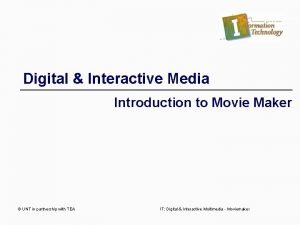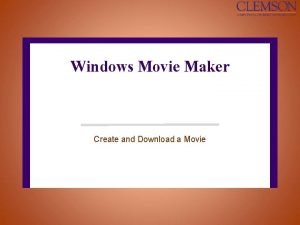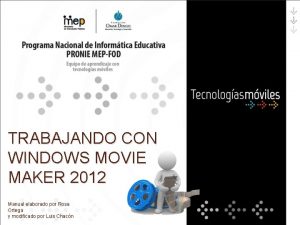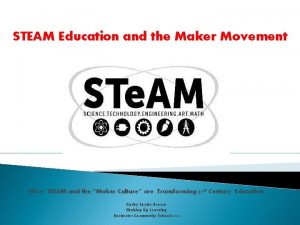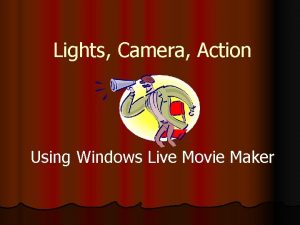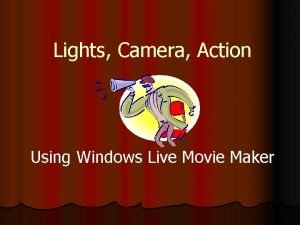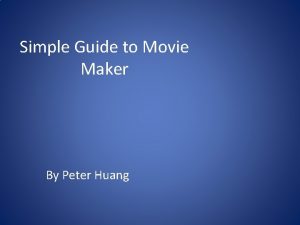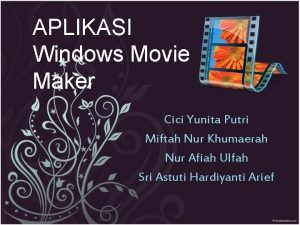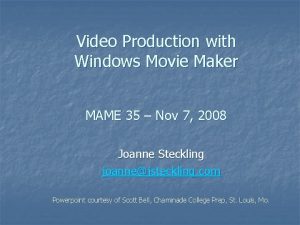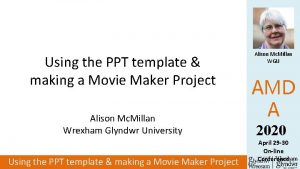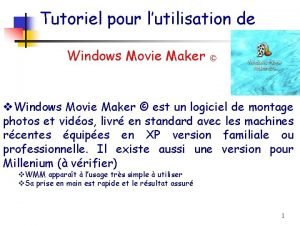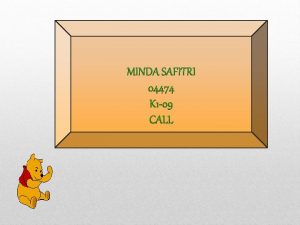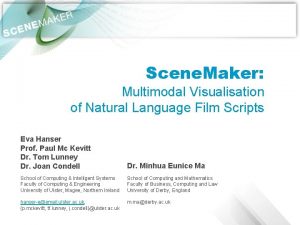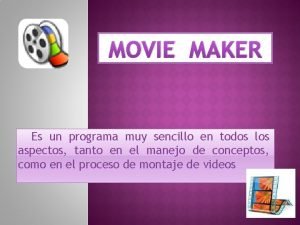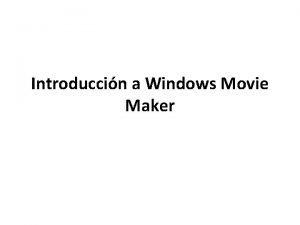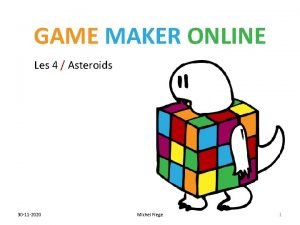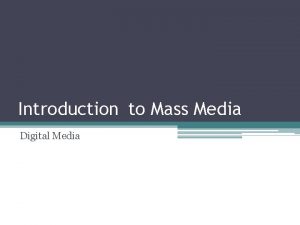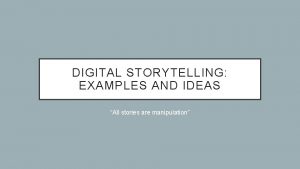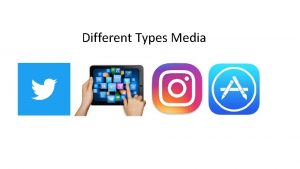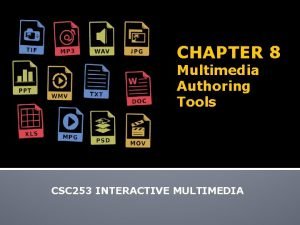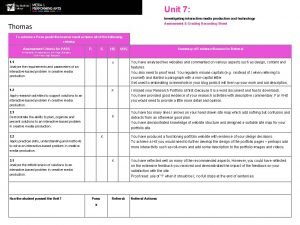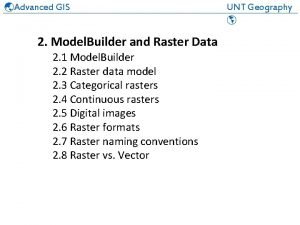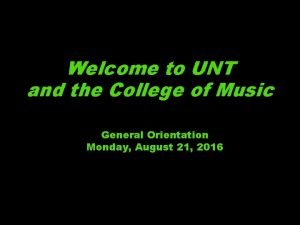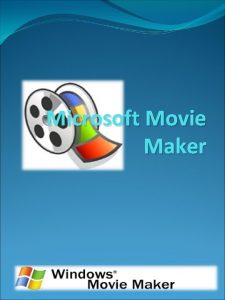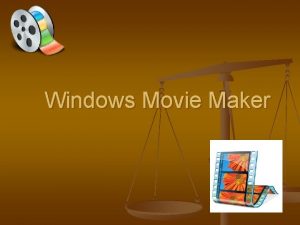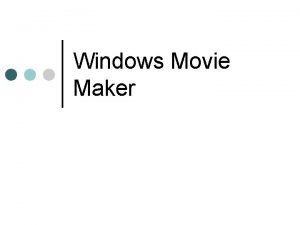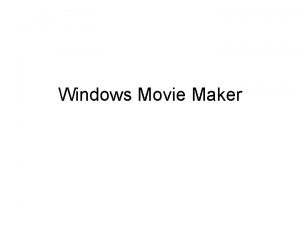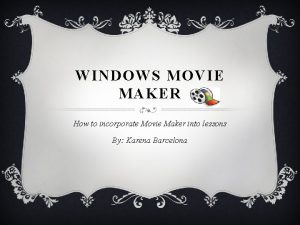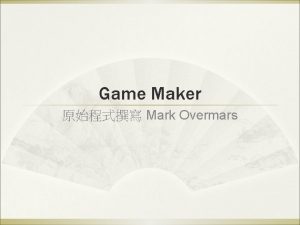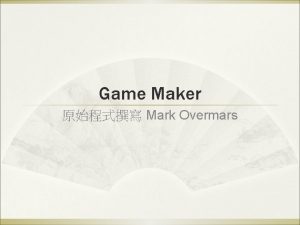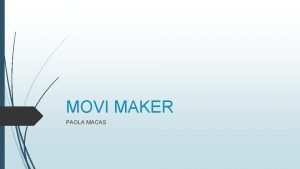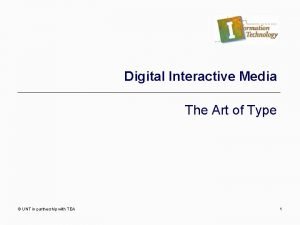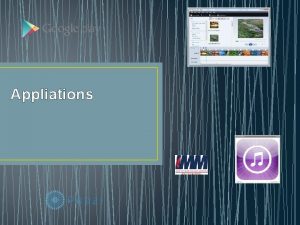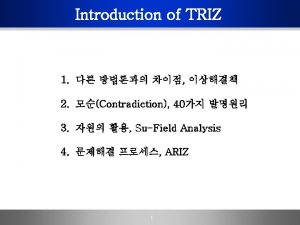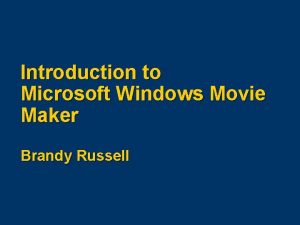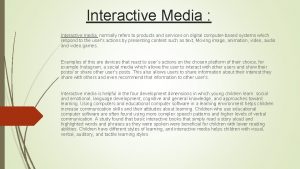Digital Interactive Media Introduction to Movie Maker UNT

































- Slides: 33

Digital & Interactive Media Introduction to Movie Maker © UNT in partnership with TEA IT: Digital & Interactive Multimedia - Moviemaker

Movie Maker I. Video editing software can turn stills, video clips and animation into a finished production. © UNT in partnership with TEA IT: Digital & Interactive Multimedia - Moviemaker

Movie Maker II. Moving making requires the following process: A. Write a short pitch script to outline the concept. B. Write a full script. C. Plan for your shots and all the equipment and people you will need. © UNT in partnership with TEA IT: Digital & Interactive Multimedia - Moviemaker

Movie Maker D. Gather all the video, animation and audio needed for the production. E. Edit your project with transitions and effects. F. Render the project in the format needed. G. Have an objective party view and provide feedback. H. Make adjustments based on the feedback and render or export the film again. © UNT in partnership with TEA IT: Digital & Interactive Multimedia - Moviemaker

Movie Maker III. Vocabulary Effects – Artificially created or enhanced sounds or images. Imported media – Audio, animation, video and/or stills which have been browsed for or captured into a video editor. Player controls – The play, stop, pause, forward and back buttons. © UNT in partnership with TEA IT: Digital & Interactive Multimedia - Moviemaker

Movie Maker Preview window – The view port on a video editor. Script – the dialogue and instructions for a performance. Storyboard – A series of illustrations or images displayed in sequence for the purpose of pre-visualizing. © UNT in partnership with TEA IT: Digital & Interactive Multimedia - Moviemaker

Movie Maker Timeline – A time ruler on which video clips are added in sequence. Title overlay – One of the timelines used to add titles over images. Transitions – Gradual change from one clip to another. © UNT in partnership with TEA IT: Digital & Interactive Multimedia - Moviemaker

Movie Maker IV. Open “Windows Movie Maker” with the start button, the desktop icon or the “Programs Folder” as you would any program. This is the video editing software which comes free with windows operating system. © UNT in partnership with TEA IT: Digital & Interactive Multimedia - Moviemaker

Movie Maker A. B. This is the interface for Windows Movie Maker. Notice the menu, preview window, player controls, and a storyboard/timeline. Menu Preview window Player controls Storyboard/timeline © UNT in partnership with TEA IT: Digital & Interactive Multimedia - Moviemaker

Movie Maker V. Save your project file where you teacher asks you to save it. A. Use the required naming system. B. The most common naming convention is Last Name, underscore, First Name, Underscore, Class Period Number and the name of the project as shown in the example: broome_joe_1 Movie. Maker. Intro © UNT in partnership with TEA IT: Digital & Interactive Multimedia - Moviemaker

Movie Maker VI. This is the window that opens if you attach a camera with a firewire cable or click the “Import from digital video camera” selection on the left. © UNT in partnership with TEA IT: Digital & Interactive Multimedia - Moviemaker

Movie Maker A. Next you browse to find the folder where you wish to save the video. B. Next you will be given the option to import the entire videotape or just parts. In most cases you will want to save hard drive space by selecting the second option. C. When you see the Player/Recorder controls you know your camera is being controlled by the computer and you can rewind, play and capture the parts you need for your project. © UNT in partnership with TEA IT: Digital & Interactive Multimedia - Moviemaker

Movie Maker VII. You will need to select Import Video and browse to the hard drive or shared drive where your teacher has saved them for you. Click on “File, ” then on “Import into Collections” to browse. © UNT in partnership with TEA IT: Digital & Interactive Multimedia - Moviemaker

Movie Maker VIII. Then you will select each of the videos, press the Play button below and watch until you get to a portion of the video which you do not need. A. They can all be shortened a little by pressing the Split Button and then deleting the unneeded part. Be careful to delete the clip you mean to delete because it can be confusing. IT: Digital & Interactive Multimedia - Moviemaker © UNT in partnership with TEA

Movie Maker IX. Next click on Import Pictures. You will need a still image which you can get from the sample images folder on your computer, browse to where your teacher has saved one for you or find an image on the internet © UNT in partnership with TEA IT: Digital & Interactive Multimedia - Moviemaker

Movie Maker X. Next select Import Audio or Music and browse for music to add to the project. All of the items you have Imported will be visible in the large open area. © UNT in partnership with TEA IT: Digital & Interactive Multimedia - Moviemaker

Movie Maker XI. Get the animation video “Sample. Animation” from your hard drive or the shared drive where your teacher put it for you. Now you have all your media assembled to create your short film or presentation about connecting a camera to a computer. © UNT in partnership with TEA IT: Digital & Interactive Multimedia - Moviemaker

Movie Maker XII. The first thing you will need is a title at the beginning. Click on Edit Titles and Credits and select “Title at the beginning”. The suggested words are “Connecting A Camera To A Computer”. © UNT in partnership with TEA IT: Digital & Interactive Multimedia - Moviemaker

Movie Maker A. Here you can change the size of the font and anything else just like a word processor. B. If you select “Change the title animation” you can pick something more like your style. © UNT in partnership with TEA IT: Digital & Interactive Multimedia - Moviemaker

Movie Maker XIII. To give yourself more control select the Storyboard button at the bottom and choose Timeline instead. Here is where you can move the title, you just made, down to the overlay portion of the timeline to make room for the still image. © UNT in partnership with TEA IT: Digital & Interactive Multimedia - Moviemaker

Movie Maker A. See how you can click and drag the still image down onto the timeline after the title has been moved to the “Title Overlay” row. B. You can view the results on the “Preview Window”. © UNT in partnership with TEA IT: Digital & Interactive Multimedia - Moviemaker

Movie Maker XIV. To give yourself more control, select the Storyboard button at the bottom and choose Timeline instead. Here is where you can move the title, you just made, down to the overlay portion of the timeline to make room for the still image. © UNT in partnership with TEA IT: Digital & Interactive Multimedia - Moviemaker

Movie maker A. See how you can click and drag the still image down onto the timeline after the title has been moved to the “Title Overlay” row. B. You can view the results on the “Preview Window”. © UNT in partnership with TEA IT: Digital & Interactive Multimedia - Moviemaker

Movie Maker XV. Now drag the music clip down to the Audio/Music portion of the time line. Remember that a video editor uses a lot of your computer’s resources, so save often and make your changes with care because reckless changes cause the system to freeze. © UNT in partnership with TEA IT: Digital & Interactive Multimedia - Moviemaker

Movie Maker A. Adjust the volume of the sound by right-clicking on the audio/music track and selecting “volume”. B. Use the slider bar to adjust the volume. © UNT in partnership with TEA IT: Digital & Interactive Multimedia - Moviemaker

Movie Maker XVI. Drag your first video clip to the timeline (0001 Video. Clip). A. Now select the clip that you just dragged to the timeline. B. Select “Titles and credits”. C. Select “Title before selected clip”. © UNT in partnership with TEA IT: Digital & Interactive Multimedia - Moviemaker

Movie Maker D. Type in the words, “You can use firewire or USB connections”. E. Select the font and animation for this text box and when you are done select “Add Title”. F. Next, right click on that title you just added to see that you can add Effects by right clicking the clips. Select Effects. G. When you get the Effects window choose, “Slow Down, Half. This is one way to get the slow motion effect or make a title last longer. © UNT in partnership with TEA IT: Digital & Interactive Multimedia - Moviemaker

Movie Maker XVII. Drag the rest of the clips to the timeline and add titles to the ones that you think need it, but this time select “Title on selected clip”. XVIII. Now change the timeline back to “Storyboard” so you can see the little transition boxes between the clips. © UNT in partnership with TEA IT: Digital & Interactive Multimedia - Moviemaker

Movie Maker A. Drag the effects you wish onto the transition boxes. Be deliberate with your choices because this is often the time that computers freeze up. B. Select the last clip and right click on it and select “Effects”. Then select the “Fade Out To Black” option. © UNT in partnership with TEA IT: Digital & Interactive Multimedia - Moviemaker

Movie Maker C. Switch back to the timeline and move the play head to the end of your video with the music selected. Then click the “Split” button and delete the portion of the music after the last clip of video. Right click on the music and select “Fade Out”. © UNT in partnership with TEA IT: Digital & Interactive Multimedia - Moviemaker

Movie Maker XIX. To save the video A. In this case you will want to select “Publish to” and “This computer”, browse to the folder where you wish to save the finished film, and give it a name like the one we discussed earlier, so your teacher can grade it. B. Select the “Best quality for playback on my computer”. C. When you click OK the video will begin to render into the folder you selected in the format you selected and you will be given the option to play the video immediately after it finishes. © UNT in partnership with TEA IT: Digital & Interactive Multimedia - Moviemaker

Movie Maker XX. We made a Movie! It’s tempting to think that you are all finished after all that work but it is hard to be objective about something you have created yourself. This is why it is so valuable to let others see your work and make adjustments instead of thinking of reasons why the mistakes are OK. © UNT in partnership with TEA IT: Digital & Interactive Multimedia - Moviemaker

Movie Maker XXV. Now use your own digital images or those you find on the internet to make a video about your favorite subject, which is not violent, racist, sexist or against the law. © UNT in partnership with TEA IT: Digital & Interactive Multimedia - Moviemaker
 Windows live movie make
Windows live movie make Interactive films maker
Interactive films maker Copywriting for digital/interactive media:
Copywriting for digital/interactive media: Windows movie maker file types
Windows movie maker file types Movie maker 2016
Movie maker 2016 Windows movie maker 2012 download
Windows movie maker 2012 download Steam education
Steam education Windows movie maker 2011 download
Windows movie maker 2011 download Movie maker 2011
Movie maker 2011 Windows live movie maker microsoft
Windows live movie maker microsoft Movie maker guide
Movie maker guide Windows movie maker download microsoft
Windows movie maker download microsoft Fungsi movie task pane
Fungsi movie task pane Windows movie maker
Windows movie maker Windows movie maker ppt
Windows movie maker ppt Manuel movie maker
Manuel movie maker Windows movie maker is an authoring tool.
Windows movie maker is an authoring tool. Windows movie maker game
Windows movie maker game Movie scene maker
Movie scene maker Ivonos
Ivonos Windows movie maker
Windows movie maker Michel fiege
Michel fiege Digital media introduction
Digital media introduction Example of digital storytelling
Example of digital storytelling Types of interactive media
Types of interactive media Features of macromedia director
Features of macromedia director Interactive media unit
Interactive media unit Unt concur
Unt concur Unt vacation accrual
Unt vacation accrual My unt login
My unt login Marko unt
Marko unt Unt physics
Unt physics Unt geography
Unt geography Linda strube unt
Linda strube unt

